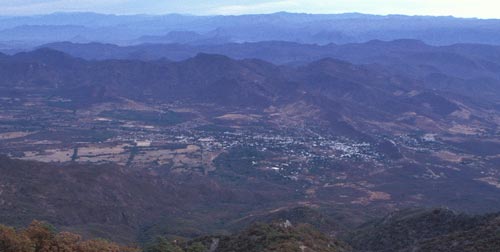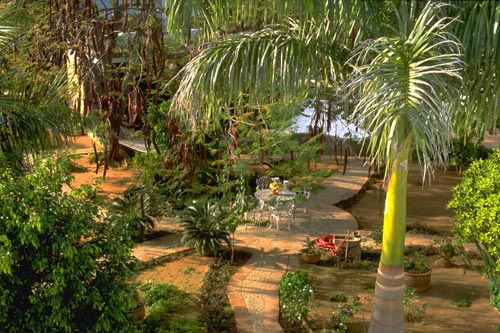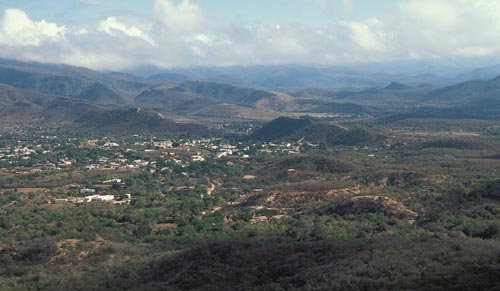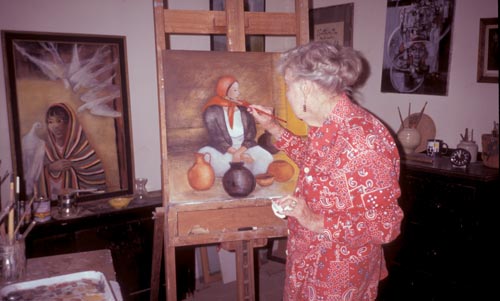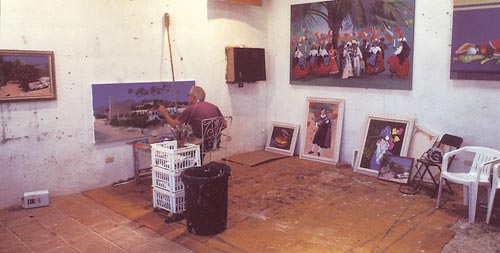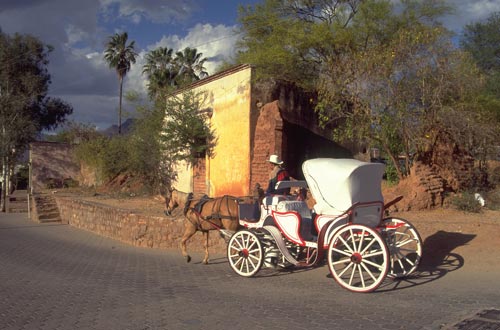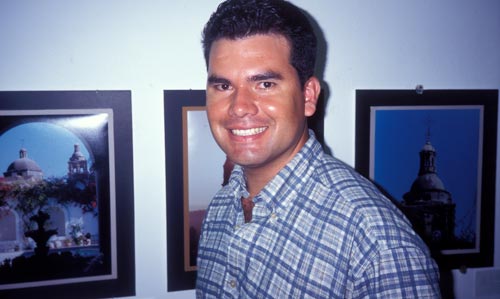Journal entries 21-30
Last modified: June 7, 2013Night Scenes… cattle and El Camino Real… late Spring, mountain views of Alamos and hornet hive… highways and roads… Jacoby gardens and gardening… El Pedregal, Elizabeth & Pember Nuzum, Calle Comercio #2… Margo Findlay and Jim Wilson… Maria Felix and Calle Galeana #41… Antonio Figueroa… Plaza waking up…
30 … Imaginations soar with night when all one can see is lit by man or moon…
In the night, things from the past bump into modern moments. As example, aged columns, scarred by events that rushed through time, are illuminated by electricity. As example, Sonora and Sinoloa were merged into a new state of Occidente and in November 1827 Alamos was declared its capital. On January 10, 1828, Governor Jose Maria Gaxiola moved into his official residence behind the walls seen above. Here, decisions were made that shaped those days, life was lived to match royalty in Spain and the mines to the west were in full production and… You are here…
If that police pickup truck, parked across the street from the Police station, wasn’t there then where could we be, and when? The answer is Alamos, Sonora, Mexico circa both 1800 and 2011. This is a portrait of power. At the western end, the cobblestones leads one up the steps and into the Cathedral’s side doors. Down the block to the east, the Governor and Bishop mansions were, and are, across the street from one another. Thousands of miles to the east is Spain, thousands of miles to the west is China and at one time they were both here, and today their DNA marches on.
On the way into Alamos Centro a regional – basic care hospital is setback on the right. At night, this scene could be an emergency room anywhere in the world. I had need to visit after one long difficult day into night. The doctors were here in Alamos for one year’s mandatory service, a bridge between medical school and where they would go to make their livings. That night, my doctor came from outside Guadalajara and hoped he would be going to Tijuana, to be on the frontier of modern Mexico. I was impressed by how he looked me in the eyes, how he touched and probed, and by the questions he asked and how he listened and responded to my answers. He was in the moment, and the moment was all about bringing me comfort. It was not about profit or loss. It was about me.
X-rays were needed to evaluate what was happening in my chest. Alas, their x-ray machine was down for repairs. He gave me a shot to reduce my discomfort and asked me to bring him back chest x-rays. He had done all he could do. The morning began meeting the Police chief in his office, at his request, and ended up on a midnight taxi cab ride to Navajoa in search of x-rays. And this day will be another of the twelve Alamos short stories I am preparing to write.
Tis the Season of Love and Jackets.
Christmas in the Plaza de Las Armas is a time of of sharing and joy. Food, fireworks and the town coming out to be seen and see is what community is all about. Video…
29 … Cattle and roads, history and food, lifestyle and occupations, ranches and town.
Sonoran cattle are known for their flavor. Alamos is surrounded by cattle ranches. This is an important aspect of the region’s economy. Hoof beats, clanging cow bells, and cowboy shouts add to the daily music that is Calle Miquel Hidalgo y Castilla, a busy and important street. This small cattle herd is headed west out of town to somewhere out there where the nearest neighborhood is that distant hill or lonely tree.
Yes, this is the famous El Camino Real. If you are from the coast of Southern – Central California you might drive on a portion of El Camino Real today. If you follow these cattle, and just keep on going you could end up in Petaluma, CA.
At this moment, we are just past the Alamos airport. Alamos, Sonora, Mexico is behind us and the future of the Californias is ahead. Onward to San Francisco, Monterey, Santa Barbara, Los Angeles, San Diego and points in between. I spent part of my childhood near the El Camino Real, when it was an undivided two lane road with dirt shoulders, in Encinitas, CA. Today, that segment is six lanes wide with additional bicycles lanes, parking spaces and curbs. As I watched these cattle disappear around the bend I could hear my voice, laughing as a child, exploring undeveloped countryside way back when.
Cattle go anywhere and everywhere across and through Alamos barrios, fields, deserts, forests, hills, mountains … There are cattle loose on top of Mt. Alamos. They are wandering in Arroyo La Aduana, Arroyo Aqua Escondida and Arroyo La Barranca. They go places no man has been. These peaceful cattle were about 30 minutes out of town on a trail into the Sierra de Alamos. Nearby, a ranch hand was pulling up a bucket of water up from a well. And so it is…
Not that long ago the best way to travel to Alamos was by mule train.
Alamos has a 5,000 foot runway, at 1,300 feet elevation, awaiting your landings and takeoffs. The Alamos City Airport, to the west, is minutes away from downtown. Talk about arriving first class. Video…
28 … Late spring as seen by high up both sides of the Alamos Valley…
I always looked north from Plaza de las Armas at two peaks that reminded me of camel humps. I knew they would provide a wonderful vantage point of Alamos and surroundings. Chon, my guide ,and I started up a trail early on an overcast morning. Two others, possibly miners, with a supplies burdened burro, were ahead of us. High up, they took a fork in the trail to the east and we continued climbing to the west. I was hoping the sun would break through. It didn’t. We reached the top under cool cloud cover. I would later learn this was a blessing. I began to film. We now go back in time to this moment contemplating the big picture. Timeless.
A week later, Chon and I spent two days and a night atop Sierra Alamos. Gringo Point is a rock outcropping that looks down directly on Alamos. Truly a bird’s eye view. Again, overcast persisted. But what can one do but do what one does? Chon created a fire in the high altitude morning chill, a bed of embers no wider than his palm with a flame no longer than his thumb, and brewed me a cup of tea. I unpacked three bags of camera equipment and began to film. We did not talk. Below, a church bell persistently called for morning mass. And we could hear the past that becomes today and will be tomorrow. I have never forgotten that civilized cup of tea.
One of 1996’s summer-photo-expedition goals was to return to the camel humped rocks. Local photographer Antonio Figueroa joined me on an effort to repeat the spring shoot. We knew summer heat and humidity would challenge us. We set off early in the morning. When we left the trail at the base of twin peaks we ran into a dense jungle of tangled vines, limbs, overgrown brush, stickers… We couldn’t get to the top. The air became hotter, oppressive, as the sun climbed into a watery sky. We had to return without our photos. Talk about disappointment, but it was what it was. And it would become worse. On the way down, Antonio ran head first into a hornet hive. If you could see Antonio’s swollen face in the photo on the trail you would realized his pain. As soon as we reached Alamos he went to the hospital for treatment. A tough day was had by all, but none tougher than Antonio’s attempt to capture the big picture. Jungle one – photographers zip.
27 … The year is 1996, signs proclaim, to travelers and citizens, Alamos approaches…
Turning east, off north – south Federal Highway 15 in Navajoa, begins an interesting 34 mile ride on Sonora State Highway 162 as one slowly climbs foothills of the Sierra Madre Occidental mountains. Volcanic outcroppings to the north create horizons from another world, alien, mysterious, engrossing. Alamos, Sonora, Mexico is ahead.
One has passed imposing Cacharamba, Minas Nuevas, the gateway to Aduana, and is gradually descending into the Alamos valley. Sierra de Alamos fills the southern horizon. The Chihuahua Sierras, home to Copper Canyon, are the eastern horizon. And then, one is entering Alamos. I am sure this sign, which was the City population at that time, has changed. Mining to the north has brought workers to live in Alamos. And it seems everywhere one goes there are more people, as long as there is food, water and shelter. The most recent Alamos population figure, which includes all of the Alamos municipality, nearly 4,200 square miles, is 24,493
If you take a moment and study this sign you will see the letters A-l-a-m-o-s emerge from the age, rust and dust of what was once the main entrance into town. This is El Camino Real, extended in 1700 from Culican northward through El Fuerte, Sinoloa and into Alamos, Sonora. Mexico. In 1690, long pack trains, loaded with silver, passed this spot on their way south to Mexico City. This was one of the most important roads in Mexico. Times change. When I first arrived in Alamos there was talk of a Federal Highway being built here, following El Camino Real south. Thankfully, it was only talk. Highways have a way of changing land, cultures and ways of life.
A parade of lights brings song and joy to colonial Alamos streets during Christmas.
We see a traditional Posada visiting from house to house and arriving at Casa de los Tesoros where children in their holiday attire play and adult family take in another Christmas in Alamos. It is a tradition. Another scene is a trip to the Alameda. Video…
26 … Learning what, how, when and why all these plants and trees grow.
Gardening and passion are one in the same for many that embark on horticultural adventures in Alamos. There are right ways, wrong ways, and the ways of trial and error. There are friends, neighbors, hired help, books and the internet to help one plant, raise and blossom. It is about design, texture, color, creating and life itself.
It is better to have planted and lost than never planted at all.
I took this photo of Judith Jacoby’s gardens in 1983 with Gaspar Vega standing amongst an explosion of spring blooms. This property was once a tequila factory warehouse owned by the Urrea family. The many Jacoby gardens start in court yards surrounding the house and spread out into large open areas. These are formal gardens set in a landscape that changes dramatically with the seasons. I will return to further explore her gardens in future posts. Gardens, in general, provide Alamos, hopefully, controlled splashes of color.
The flora of Alamos is the many splendors of Sinaloan tropical forest and Sonoran desert living together in unexpected harmony. Many properties have gardeners watering, pruning, consulting, planting, cutting, raking, commiserating, trimming and… year round. Flowers and vegetables are planted in November for winter blooms and crops that last until May or June’s heat… Mangos, papayas, bananas, palms, amapas, orchidias and other trees provide food and shelter for native and migrating birds. Cascades of colors come from flowering vines: blue veracruzana, orange trumpet, red, magenta and orange bougainvilla and… And the smells and scents that envelope one’s senses… Formal, informal… it all contributes to this symphony and riot that is the passing seasons in Alamos, Sonora, Mexico.
Behold a Cornucopia of Color, Shapes, Textures and Scents.
Alamos has six seasons a year and a diversity of native and imported flora. Gardening is both a passion and industry. It can become all consuming. It can be an mental oasis, freedom from the outside world’s cares and concerns. And it is something to share with those who visit, be it bug, bird, mammal or human. Video…
25… Location, location, location: there are places that are more than places.
Today, summer of 1996, would start with a hike to the top of Tecolete Hill, seen here sun capped. Sierra de Alamos rises up in the background. We are at El Pedgral standing near a beautiful palapa, the first structure Elizabeth Nuzum built after buying three acres outside of Alamos to the west. This was her project, her dream to bring art, community and nature together under the out stretched limbs of a magnificent fig tree. She would sell the property to Jennifer and David MacKay in 2005. They added another 17 acres to what is now El Pedegral Nature Lodge and Retreat Center. One of my twelve Alamos short stories will be about how Elizabeth’s strawbale studio was originally painted with a palette of color made from dirt in the surrounding hills.
Two hours later, after a relaxed hike, we were breathing in mentholated vistas east and north. And there is Alamos, Sonora, Mexico, seen for what it is, a village on the pathway to tomorrow. And directly below, in the overgrown seasonal jungle, there is El Pedregal, “place of rocky terrain“. Off to the right, there are rainbow veins of colors that abstractly paint the ground: orange, green, blue, yellow, grey, white, ochre…
Pember and Elizabeth Nuzum lived on Calle Comercio off the Plaza de las Armas. This is the center of town and visitors came from around the world and from different times, like myself. El Pedregal was Elizabeth’s Shangri-La. Here, she visualized and directed the effort to accomplish what could be. The Nuzums, like many of the North American community, were involved with the daily fabric of Alamos life. Their house help and workers became extended family, each casa a little village unto its own. From here, behind these walls, Elizabeth conjured a new frontier and blazed a trail that included landscaping, constructing and crafting her El Pedregal. These dreams are shared by many in Alamos, be it envisioning a new wall, choosing and planting a plant, determining a color, supporting a civic interesting, developing and sustaining a community project…
Alamos, Sonora, Mexico is a place for being.
Pember told Anders, “always call us Alamos, Sonora, Mexico.” And Anders has.
Pember and Elizabeth Nuzum were a major part of the North American Community for decades. Their casa next to the Church on Calle Comercio #2 greeted many who visited Alamos, including Anders. It is not uncommon to have rain squalls in December. And it was common to hear Pember playing his theater organ in the Nuzum music room. Those days are gone. But the spirit lingers, it always does. Video…
24 … Two studios, two artists, two approaches, one town, one world…
This is what one was greeted to as they entered Margo’s home from the street. The space was her work, her moments. Here, Margo had all she needed. The expansive walls and high ceilings of Alamos provide wonderful studio – gallery space for artists.
Margo Findlay was born in Lewiston, Montana, 1906, and spent her childhood on cowboy ranches in the American old west. At the age of 17 she started to illustrate children books and then across a life that lasted 104 years she traveled, danced, and did what she what she did. After knocking on her door and coming in for a brief visit, and these photographs, I understood her way was not to talk about art, it was to do.
I could not find much written about Margo Findlay. In one piece she was described as “expressionist artist”. She came to Alamos in 1964 with her artist husband, Harold Findlay. She never left. She is buried in Alamos, she is part of Alamos. Think of all the hours she spent painting, alone in her thoughts and technique. The artistic life requires self-discipline. A drive to create-make-reflect-share-react. An artistic life is one of being the art. Margo.
James Fenimore Wilson escaped from the New York art scene to spend six months in Alamos, Sonora, Mexico. The year was 1990 and he felt a need to recharge his creative powers. Here he found another life. He met his future wife Lourdes, born and raised in nearby Navajoa, at the Plaza while she was visiting Alamos. They had two children and left Alamos in 2000 for Jim’s college teaching – painting position in Missouri.
When I visited with Jim during the 90’s he was the most visible of the town’s working artists. His work was seen in homes throughout Alamos. His portraits became integral to the families that commissioned them. Jim’s extensive art background allowed him to talk with in-depth knowledge of art. Over the hundreds of years, Alamos has given refuge and wings to the creative spirit. It is as much a part of the landscape as the mountain.
23 … The view out this window has changed over the past century…
1914 was in the middle of turbulent times for the region. Yaquis and Mayos were joining forces with Obregon and Villa’s armies. Venustiano Carranza became the third Mexican President in two years. One of them, Francisco Madero, was assassinated. Hard times were here. Maria de los Angeles Felix Guerrean was born April 8, 1914. This window looked out from her birth place. She had eleven sisters and brothers. They lived here until 1929 when they left for Guadalajara. Soon her beauty would be nationally recognized.
This is where Maria Felix was born and raised, riding horseback in a land that was losing its mines. Her father was of Yaqui Indian blood and her Spanish blood mother was raised in a Pico Heights, California convent. Much of the beauty that is seen in the faces of Alamos is a product of interlocking bloodlines that span the globe. There are European, Asian, eastern Indian, Philippine and indigenous Indian features across town. Maria described herself as ” a woman with a man’s heart.” She was a commanding presence, a beautiful liberator, a woman beyond her times. She made 47 films in Mexico and France. She became internationally recognized. She published a bestselling autobiography in 1993, All My Wars. And this is where her life’s journey began..
Hurricane Fausto was the storm that leveled the walls. The window is gone. Galeana #41 is now a mother of all ruins. A passing carriage takes tourists around town. Tomorrow would be another day. In 1999, Lynda Barondes bought Galeana #41. She was to learn later that this was the birthplace of Maria Felix. In 2002, part of Lynda’s restoration efforts, a Museum opened here with three rooms dedicated to the spirit Maria Felix embodied. The Museum closed in 2012 as Lynda sold the property and moved to the nearby southern foothills overlooking Alamos.
Buckle-up as we take a super fast-rock n’ roll car ride through Alamos on a grey winter day.
Driving Across Alamos on an overcast December day starts at La Puerta Roja Inn. We head east and circle the Plaza de Las Armas before heading to the Panteon – Cemetery. We head back to La Puerta Roja exploring different routes. The best way to travel is walking. Video…
22 … Mexico’s best friends are its hard working photographers…
Antonio, I am glad to hear, remains a professional photographer in Alamos, Sonora, Mexico. He was of great assistance during my 1996 summer shoot. His enthusiasm for what he was doing, and eagerness to try new things, made him a great working companion. Antonio Figueroa knows he lives in a special place filled with family, friends, man-made and natural beauty.
If American photographers think life is hard try stepping into a Mexican photographer’s shoes. The market is limited by the their customers incomes. And most of these people can only afford photos of turning points in their family life. For artists like Antonio, it is a balancing act to pursue his love of landscape, light, form – magical moments camera lens create and capture – with little market demand for these efforts. These were the days of film cameras which costed much more in Mexico than the USA. Antonio did not have access to the film stocks I was shooting. In some cases he would need to ride a bus for half a day to find film for a shoot, and there was no guarantee it was on the shelves. I hope the digital age is making life easier for professional Mexican photographers.
Antonio was part of fotoseptiembre which ran for the month at the Museo Constumbrista de Sonora in Plaza de las Armas. He is seen here with his work. It took a great effort to frame his pieces as he did. No shortcuts. I have selected twelve events or people as subjects for short Alamos essays. Antonio is one of these amazing stories. More to come.
This is a Blessed Season for a Multitude of Reasons.
In mid-afternoon the air pressure begins to drop and a stiff wind sweeps the valley from the west, a storm is coming. Night falls and showers start. We go from the Plaza to the Alameda and back. The following day the sun comes out and then is covered by clouds. Kids play and men work gathering sand in the arroyos. A summer day can be complex in its textures and atmospheres. Video…
21 … Everyday will sail into the plaza: its rhythms, textures, and movements in tow…
Colonial elements frame each other: The church’s east entrance is framed by its arch which is framed by a tree which is framed by a column at the corner of Calle Commercio where Casa Nuzum was – is. A procession of people will enter the church throughout the day, some coming alone for private moments and others in waves for scheduled masses. Here is safe harbor.
Predawn walkers circle the Plaza and skirt down side streets. The plaza gardener starts early, and one by one shop keepers, office workers and laborers come and go. Kids cross the plaza headed to school. Dogs wanders. Cars and pickups pass by. The same is happening in the Alameda, good morning Alamos, Sonora, Mexico!
Daybreak in the Plaza is a quiet song that slowly builds into a symphony.
As the day turns from dark to light watch Alamos come alive. Everyday is a new start, another challenge, another opportunity. The late Levant Alcorn is seen collecting bird feathers on his morning walk around the Plaza de las Armas. Video…
Return to Journal entries 11-20 or forward to Journal entries 31-40
©2011 Anders Tomlinson, all rights reserved.







